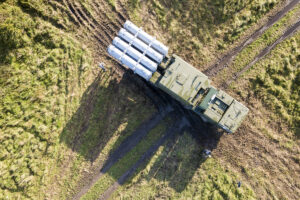On April 22, 2022, the Stimson Center convened the fifth virtual meeting of its U.S.-Russia Military-to-Military Dialogue. It was the group’s first discussion following the outbreak of Russia-Ukraine hostilities at the end of February. Thanks to the trust built over four previous meetings, the participants found it possible to have a candid conversation based on mutual understanding, despite the tensions that have dramatically reduced interactions between the two countries on all levels.
American participants in the fifth meeting included General (ret.) George W. Casey, General (ret.) Curtis M. Scaparrotti, Ambassador Karl W. Eikenberry and General (ret.) John P. Abizaid. Russian participants included Major General (ret.) Vladimir Z. Dvorkin, Colonel General (ret.) Viktor I. Yesin, and Major General (ret.) Pavel S. Zolotarev.
In his opening remarks, Stimson’s President and CEO, Brian Finlay, noted that the dialogue continues Stimson Center’s long tradition of fostering mutual understanding between the U.S. and Russia. The meeting was moderated by Stimson senior staff members: Bruce McConnell, Vladimir Ivanov and James Siebens.
The participants discussed the ongoing conflict in Ukraine and the threat perceptions of the two sides and explored potential ways to mitigate the crisis and avoid escalation of military hostilities beyond their current geographic boundaries.
Although the participants expressed disagreements on a range of issues, such as the causes of the Ukraine conflict, NATO enlargement, and others, they also voiced shared concerns on issues pertaining to international security and strategic stability.
The participants largely agreed on the following:
- The current crisis and the intensifying confrontation between the West and Russia increase the danger of escalation, which in the worst case could result in a nuclear exchange.
- Neither the U.S. nor Russia seek a direct military confrontation with one another, as both realize the detrimental effect this could have for the planet. This should be a starting point in future negotiations.
- Negotiations on strategic stability and arms control between the U.S. and Russia should resume in order to identify mutually agreeable principles and means of verification.
- Communication, on a regular basis, between senior American and Russian military officers should be established to prevent the escalation of the conflict.
Speaking about the future of this dialogue, the participants and organizers noted that there is a marked decline of the U.S.-Russia Track 2 projects as a result of the current crisis in bilateral relations. At the same time, they pointed to the importance of communication and of maintaining such dialogues in particular for building mutual understanding and addressing the differences in threat perceptions of each side. They believe such dialogues have the potential to contribute to new thinking and bring forth constructive solutions to security issues which the world urgently needs.
The U.S.-Russia Military-to-Military dialogue is made possible by the generous support of Carnegie Corporation of New York. The project was initiated by the EastWest Institute in 2020 and transferred to the Stimson Center in 2021.


